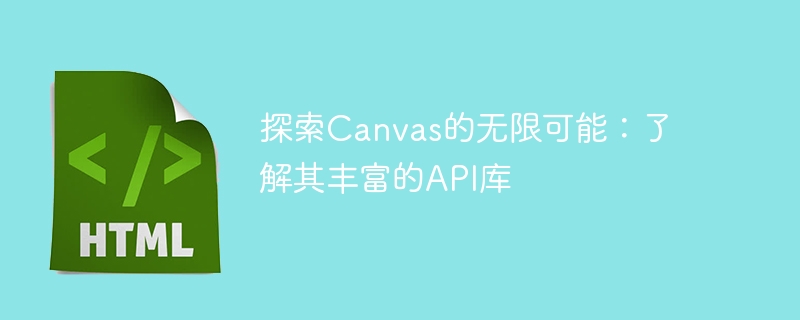

Explore the infinite possibilities of Canvas: To understand its rich API library, specific code examples are required
Introduction:
With the popularity of HTML5, Canvas has become an important tool for developing the Web. One of the preferred tools for graphics applications. Canvas is a powerful HTML5 element that allows us to draw 2D graphics and animations through JavaScript. It provides a rich API library that enables developers to create a variety of visual effects, from simple charts to complex graphics games, and even highly interactive data visualization applications.
Text:
1. Basic overview of the Canvas API library
The Canvas API library provides developers with a complete set of drawing functions that can control the position, shape, color, transparency, etc. of graphics. It contains some basic drawing functions, such as drawing paths, filling colors, drawing text, drawing images, etc. At the same time, Canvas also provides some advanced functions, such as gradients, shadow effects, image synthesis, etc., making it easier for developers to achieve cool effects.
2. Draw basic graphics
Using the Canvas API library, we can easily draw various basic graphics, such as lines, rectangles, circles, etc. The following are some commonly used drawing functions:
Draw a line
context.beginPath(); context.moveTo(x1, y1); context.lineTo(x2, y2); context.stroke();
Draw a rectangle
context.rect(x, y, width, height); context.fill();
Draw a circle
context.beginPath(); context.arc(x, y, r, 0, 2 * Math.PI); context.fill();
3. Apply gradient and shadow effects
By applying gradient and shadow effects, we can add more three-dimensional and richer visual effects to graphics. Here are some commonly used gradient and shadow functions:
Linear Gradient
var gradient = context.createLinearGradient(x1, y1, x2, y2); gradient.addColorStop(0, "red"); gradient.addColorStop(1, "blue"); context.fillStyle = gradient;
Radial Gradient
var gradient = context.createRadialGradient(x1, y1, r1, x2, y2, r2); gradient.addColorStop(0, "red"); gradient.addColorStop(1, "blue"); context.fillStyle = gradient;
Shadow effect
context.shadowOffsetX = 5; context.shadowOffsetY = 5; context.shadowBlur = 5; context.shadowColor = "rgba(0, 0, 0, 0.5)";
4. Drawing text and images
In addition to basic graphics, Canvas also supports drawing text and images. The following are some commonly used text and image drawing functions:
Drawing text
context.font = "20px Arial";
context.fillText("Hello, World!", x, y);Drawing image
var image = new Image();
image.onload = function() {
context.drawImage(image, x, y, width, height);
}
image.src = "image.png";5. Implement interactive applications
Using the event processing function of the Canvas API library, we can implement highly interactive applications, such as mouse clicks, dragging, etc. The following is a simple interaction example:
canvas.addEventListener("click", function(event) {
var x = event.offsetX;
var y = event.offsetY;
// 在点击位置绘制一个矩形
context.fillStyle = "red";
context.fillRect(x, y, 50, 50);
});Conclusion:
The Canvas API library provides rich drawing functions and complex effects, allowing developers to create stunning visual applications. This article introduces Canvas's basic drawing functions, gradient and shadow effects, text and image drawing, and the implementation of interactive applications. By having an in-depth understanding of the Canvas API library and combining it with specific code examples, we can better explore its infinite possibilities and add more visual charm to our web graphics applications. Let’s embark on a journey of exploring Canvas together!
The above is the detailed content of Explore the unlimited potential of Canvas: master its rich collection of APIs. For more information, please follow other related articles on the PHP Chinese website!
 What are the production methods of html5 animation production?
What are the production methods of html5 animation production?
 python development tools
python development tools
 Introduction to html text box types
Introduction to html text box types
 Mathematical modeling software
Mathematical modeling software
 The difference between access and trunk ports
The difference between access and trunk ports
 Virtual currency exchange platform
Virtual currency exchange platform
 html set font color size
html set font color size
 Dogecoin trading platform
Dogecoin trading platform
 How to use panel control
How to use panel control




